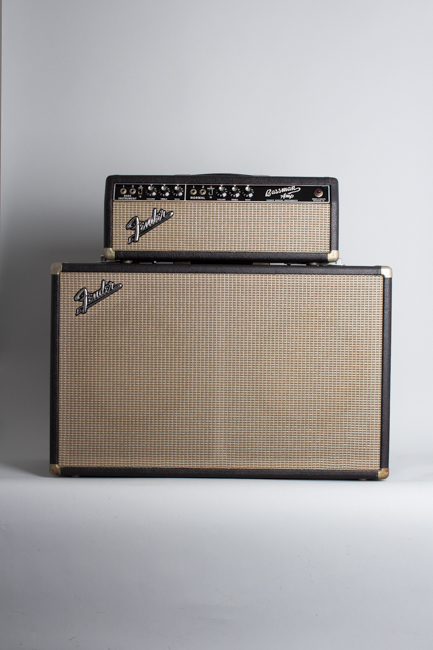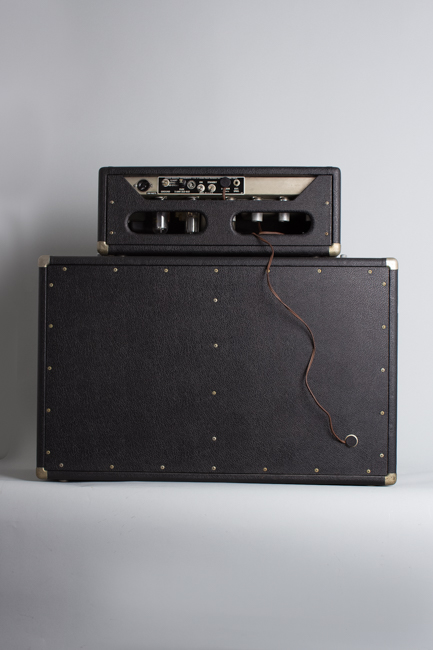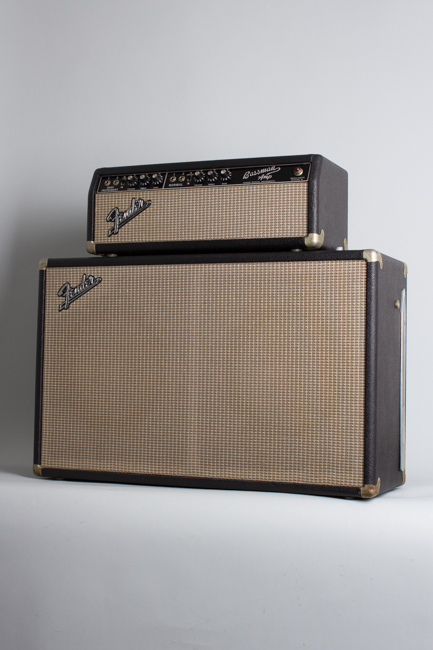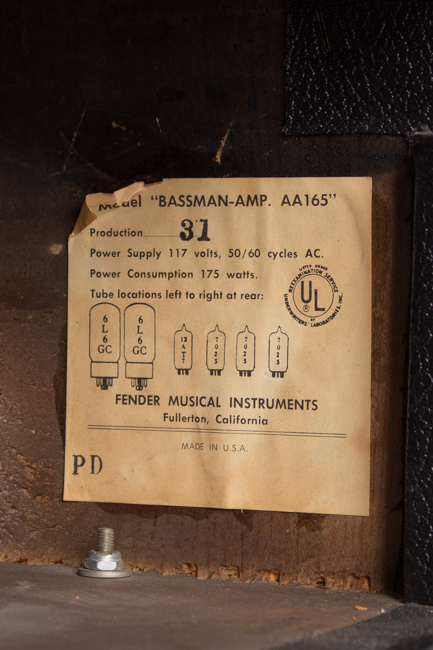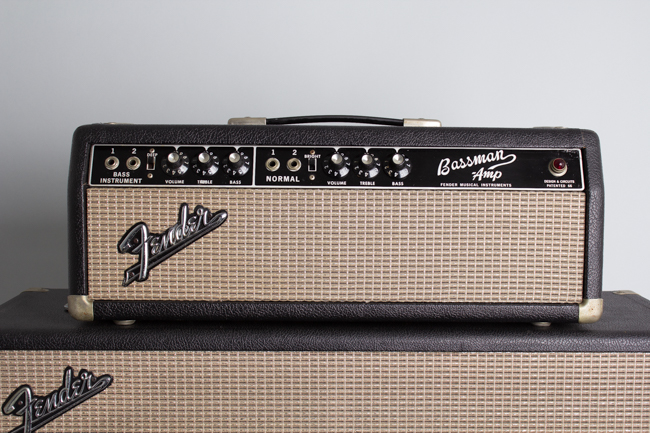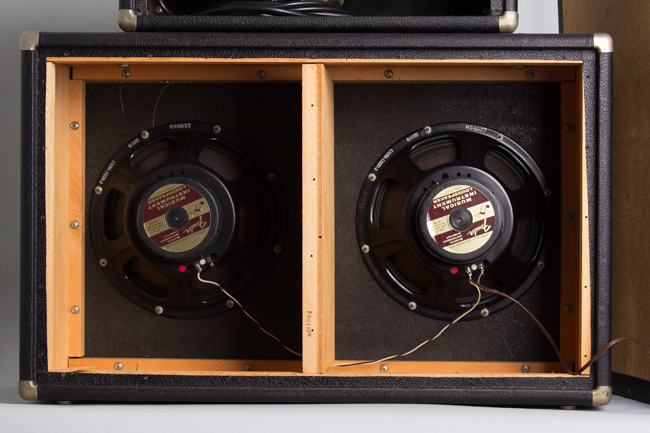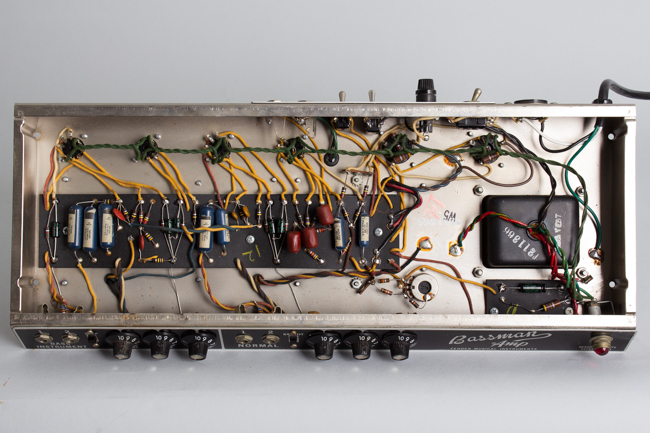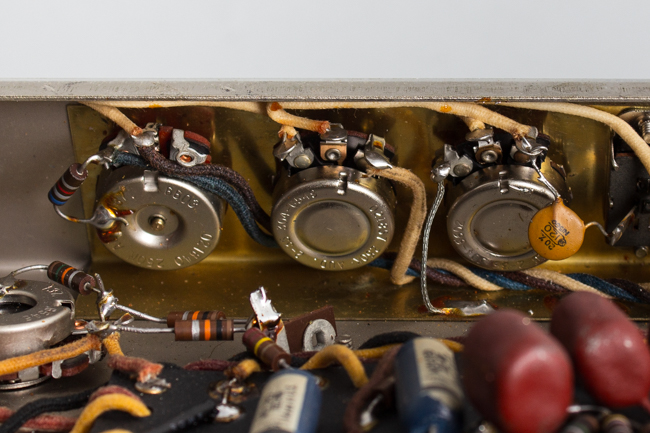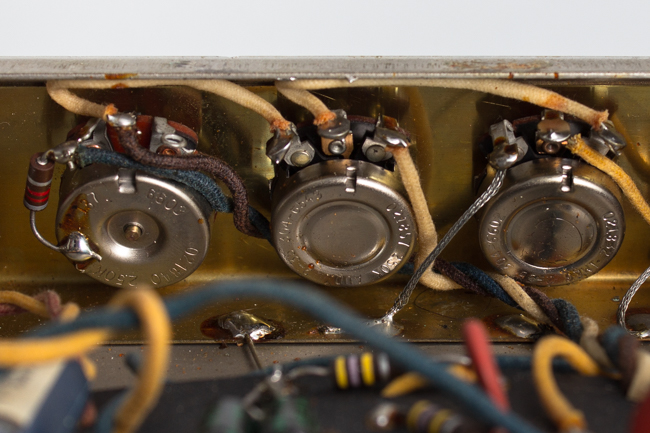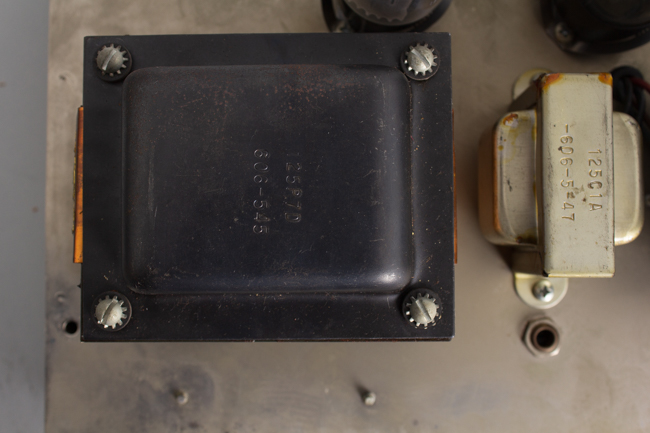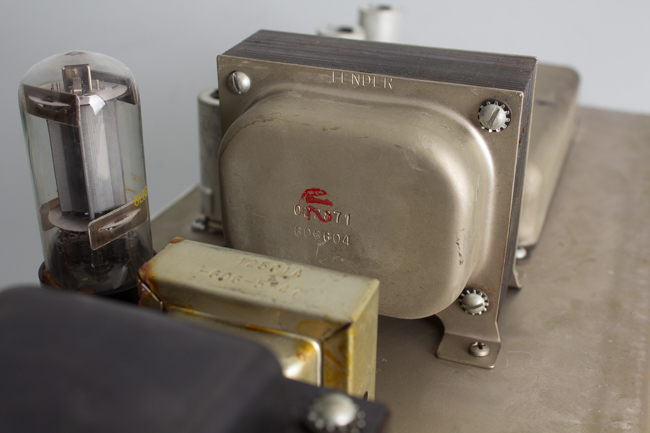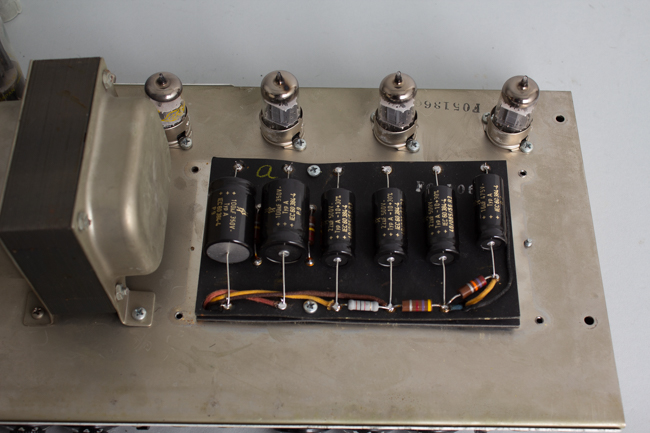Fender Bassman AB165 Tube Bass Amplifier (1966)
This item has been sold.
Item # 11824
Prices subject to change without notice.
Fender Bassman AB165 Model Tube Bass Amplifier (1966), made in Fullerton, California, serial # A-19263, black tolex covering finish.
This is a truly fabulously preserved example of the 1960s black-panel "piggyback" Fender Bassman. While its legendary Tweed predecessor was the direct inspiration for Jim Marshalls revolutionary creations, this later mid-60s iteration established a later niche as a utilitarian tube workhorse with punk, rock and garage guitarists in particular, who favored the affordably available (and very crankable) amps on the used market when a 50 watt tube amp was no longer much desired by bassists. The black panel Bassman made its most notable modern guitar-centric sonic contributions on many of Kurt Cobain's tracks on Nirvana's "Nevermind".
By mid-1964 1964 Fender changed much of their amp line considerably. Following the short-lived black Tolex and silver grille cloth-clad white knob "tuxedo" amps, further updates on the Bassman included skirted black knobs with numbers and deleting the presence control. Specifically tailored for bass instruments, the Bassman remained a fairly bare-bones amplifier while the rest of the "professional" Fender line came standard with onboard reverb and tremolo.
The new AA864 Bassman circuit featured dedicated bass and normal channels, with the former re-voiced and with an added gain stage as well as a "Deep" switch. The "Normal" channel was given a "Bright" switch. A few other changed components, as well as a lower-gain phase inverter tube encourages a later onset of clipping when pushed. The dual-6L6GC push-pull power section yields approximately 50 watts of power into two 12" Jensen speakers, housed in a separate closed-back cabinet with matching cosmetics. This head-and-cabinet format has usually been jocularly referred to as "piggyback" style.
This amp sports the AB165 iteration of the circuit, albeit the tube chart indicating the short-lived AA165 (Fender kept using up older tube charts for a considerable number of units). The circuit features a handful of changes that when pushed, the amp offers more breakup, compression and sag on both channels compared to its predecessor. While a popular amp for Fender bassists when issued, the Bassman was left behind in the much louder stages from the late '60's on and since that time has been primarily used by guitarists. In today's lower volume world it once again makes a lovely all-tube bass rig, while offering a massive guitar sound when pushed!
Height is 28 1/2 in. (72.4 cm.), 32 in. (81.3 cm.) width, and 11 in. (27.9 cm.) deep.
This amp's tube chart bears the stamp PD indicating assembly in April of 1966, just over a year into the CBS-era of Fender. Cosmetically, the amp head and cabinet are both in fantastic shape. The black Tolex covering hardly shows any notable wear. Both grille cloth coverings are impeccable as well; taut, clean and show no signs of tears or fraying. The front panel is very clean, showing only a few dings and scratches and all the knobs appear original and are nicely intact. The often-removed tilt back legs and cabinet securing bolts are also intact. The original handle and hardware show minor-to-moderate signs of corrosion overall. The amp also retains the original brown speaker cord which is in fantastic shape for its age.
Electrically, this complete nearly 60 year old piggyback rig remains nicely original. The two factory 12" Jensen C12Q speakers bear the codes 220-605 and 220-608, dating them to the 5th and 8th week of 1966, respectively. Both sport their original cones and are in great shape. The power, choke and output transformers are original as well, marked 606-545, 606-547 and 606-604, dating them to the 45th and 47th week of 1965 and 4th week of 1966, respectively. All pots date to either late '65 or early '66 as well. The amp has received our typical maintenance and servicing, including replacement of all electrolytic capacitors, a grounded 3-prong power cord, cleaning of all sockets, pots and jacks and power tubes biased to spec.
This was a second-owner amp rig, according to that owner in storage little used since the early 1970s. It remains a stellar-looking and fabulous sounding example of a beloved workhorse amp; a piggyback Fender from this era is truly rare to find in such pristine and complete condition and can even once again serve as a functional bass amp, now that the tides have turned in favor of lower-wattage amplification! Generally Excellent Condition.
This is a truly fabulously preserved example of the 1960s black-panel "piggyback" Fender Bassman. While its legendary Tweed predecessor was the direct inspiration for Jim Marshalls revolutionary creations, this later mid-60s iteration established a later niche as a utilitarian tube workhorse with punk, rock and garage guitarists in particular, who favored the affordably available (and very crankable) amps on the used market when a 50 watt tube amp was no longer much desired by bassists. The black panel Bassman made its most notable modern guitar-centric sonic contributions on many of Kurt Cobain's tracks on Nirvana's "Nevermind".
By mid-1964 1964 Fender changed much of their amp line considerably. Following the short-lived black Tolex and silver grille cloth-clad white knob "tuxedo" amps, further updates on the Bassman included skirted black knobs with numbers and deleting the presence control. Specifically tailored for bass instruments, the Bassman remained a fairly bare-bones amplifier while the rest of the "professional" Fender line came standard with onboard reverb and tremolo.
The new AA864 Bassman circuit featured dedicated bass and normal channels, with the former re-voiced and with an added gain stage as well as a "Deep" switch. The "Normal" channel was given a "Bright" switch. A few other changed components, as well as a lower-gain phase inverter tube encourages a later onset of clipping when pushed. The dual-6L6GC push-pull power section yields approximately 50 watts of power into two 12" Jensen speakers, housed in a separate closed-back cabinet with matching cosmetics. This head-and-cabinet format has usually been jocularly referred to as "piggyback" style.
This amp sports the AB165 iteration of the circuit, albeit the tube chart indicating the short-lived AA165 (Fender kept using up older tube charts for a considerable number of units). The circuit features a handful of changes that when pushed, the amp offers more breakup, compression and sag on both channels compared to its predecessor. While a popular amp for Fender bassists when issued, the Bassman was left behind in the much louder stages from the late '60's on and since that time has been primarily used by guitarists. In today's lower volume world it once again makes a lovely all-tube bass rig, while offering a massive guitar sound when pushed!
Height is 28 1/2 in. (72.4 cm.), 32 in. (81.3 cm.) width, and 11 in. (27.9 cm.) deep.
This amp's tube chart bears the stamp PD indicating assembly in April of 1966, just over a year into the CBS-era of Fender. Cosmetically, the amp head and cabinet are both in fantastic shape. The black Tolex covering hardly shows any notable wear. Both grille cloth coverings are impeccable as well; taut, clean and show no signs of tears or fraying. The front panel is very clean, showing only a few dings and scratches and all the knobs appear original and are nicely intact. The often-removed tilt back legs and cabinet securing bolts are also intact. The original handle and hardware show minor-to-moderate signs of corrosion overall. The amp also retains the original brown speaker cord which is in fantastic shape for its age.
Electrically, this complete nearly 60 year old piggyback rig remains nicely original. The two factory 12" Jensen C12Q speakers bear the codes 220-605 and 220-608, dating them to the 5th and 8th week of 1966, respectively. Both sport their original cones and are in great shape. The power, choke and output transformers are original as well, marked 606-545, 606-547 and 606-604, dating them to the 45th and 47th week of 1965 and 4th week of 1966, respectively. All pots date to either late '65 or early '66 as well. The amp has received our typical maintenance and servicing, including replacement of all electrolytic capacitors, a grounded 3-prong power cord, cleaning of all sockets, pots and jacks and power tubes biased to spec.
This was a second-owner amp rig, according to that owner in storage little used since the early 1970s. It remains a stellar-looking and fabulous sounding example of a beloved workhorse amp; a piggyback Fender from this era is truly rare to find in such pristine and complete condition and can even once again serve as a functional bass amp, now that the tides have turned in favor of lower-wattage amplification! Generally Excellent Condition.
